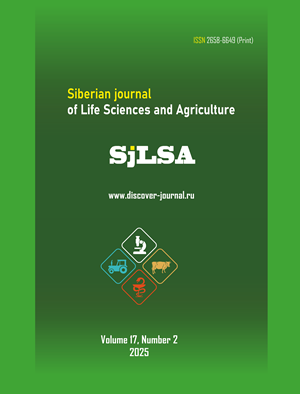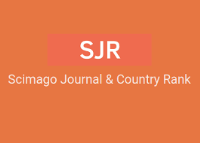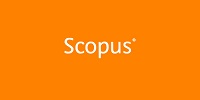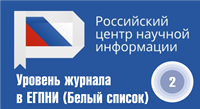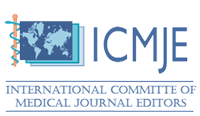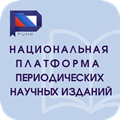Повышение качества процедур биотестирования в специализированных лабораториях
Аннотация
Background. In the methodology of bioassay, the issues of searching for target biotests, the number of evaluated test-functions of organisms, as well as maintaining the sensitivity of the test-culture in the range specified by the methodology remain problematic.
The aim of the study was to generalize scientific approaches that contribute to improving the quality of bioassay procedures and their results: choosing the most appropriate techniques, maintaining the quality of laboratory culture, implementing systemic bioassay using several endpoints of one organism.
Research methods. During 2006-2024, research work was carried out in the laboratory of bioassay at Vyatka State University (Kirov, Russia), according to the results of which scientific approaches to improving the quality of bioassay procedures were further proposed.
Results. The paper suggests three ways to improve the quality of bioassay procedures for specialized laboratories. The algorithm for selecting the bioassay method should be based on determining the sensitivity of the available methods of analysis. The approach works when the main pollutants (priority toxicants) are known. In addition, it is recommended to conduct regular in-laboratory quality control of the test culture, including an assessment of the sensitivity of organisms to a reference toxicant and a set of vital signs. For multicellular organisms, this is the average duration of life, the beginning of reproduction, the daily increase in mortality, etc.; for single-celled organisms, it is an increase in biomass or the number of cells. Then, in order to predict the environmental impact of pollution, it is recommended to estimate a few endpoints of exposure per standardized species.
Conclusion. The implementation of the concept of "reasonable choice of methods + quality of test-culture + assessment of the spectrum of body reactions" will save labor and time resources, obtain reproducible results, which is especially important in conditions of long-term environmental monitoring.
EDN: WVTHLI
Скачивания
Литература
Олькова, А. С. (2018). Актуальные направления развития методологии биотестирования водных сред. Вода и экология: проблемы и решения, 2(74), 40-50. https://doi.org/10.23968/2305-3488.2018.20.2.40-50 EDN: https://elibrary.ru/XUAMAP
Олькова, А. С. (2020). Разработка стратегии биотестирования водных сред с учетом многофакторности ответных реакций тест-организмов: Диссертация на соискание ученой степени доктора биологических наук. Владимир: Владимирский государственный университет, 359 с. EDN: https://elibrary.ru/IRBGXV
Capela, R., Garric, J., Castro, L. F. C., & Santos, M. M. (2020). Embryo bioassays with aquatic animals for toxicity testing and hazard assessment of emerging pollutants: A review. Science of The Total Environment, 705, 135740. https://doi.org/10.1016/j.scitotenv.2019.135740 EDN: https://elibrary.ru/VKMEUG
Finlayson, K. A., van de Merwe, J. P., & Leusch, F. D. L. (2022). Review of ecologically relevant in vitro bioassays to supplement current in vivo tests for whole effluent toxicity testing - Part 2: Non-apical endpoints. Science of The Total Environment, 851(1), 158094. https://doi.org/10.1016/j.scitotenv.2022.158094 EDN: https://elibrary.ru/HAVIHT
Frydrych, A., & Jurowski, K. (2024). Toxicity of minoxidil - Comprehensive in silico prediction of main toxicity endpoints: Acute toxicity, irritation of skin and eye, genetic toxicity, health effect, cardiotoxicity and endocrine system disruption. Chemico-Biological Interactions, 393, 110951. https://doi.org/10.1016/j.cbi.2024.110951 EDN: https://elibrary.ru/QSHBMY
Ji, X., Challis, J. K., & Brinkmann, M. (2022). A critical review of diffusive gradients in thin films technique for measuring organic pollutants: Potential limitations, application to solid phases, and combination with bioassays. Chemosphere, 287(3), 132352. https://doi.org/10.1016/j.chemosphere.2021.132352 EDN: https://elibrary.ru/HMGVHW
Johnson, M., Finlayson, K., van de Merwe, J. P., & Leusch, F. D. L. (2024). Adaption and application of cell-based bioassays to whole-water samples. Chemosphere, 361, 142572. https://doi.org/10.1016/j.chemosphere.2024.142572 EDN: https://elibrary.ru/MNOIBS
Olkova, A. S., Kantor, G. Y., Kutyavina, T. I., & Ashikhmina, T. Y. (2018). The importance of maintenance conditions of Daphnia magna Straus as a test organism for ecotoxicological analysis. Environmental Toxicology and Chemistry, 37(2), 376-384. https://doi.org/10.1002/etc.3956 EDN: https://elibrary.ru/XXDRQD
Pronk, T. E., Hoondert, R. P. J., Kools, S. A. E., Kumar, V., & de Baat, M. L. (2024). Bioassay predictive values for chemical health risks in drinking water. Environment International, 188, 108733. https://doi.org/10.1016/j.envint.2024.108733 EDN: https://elibrary.ru/LYZOUG
Rakaj, A., Morroni, L., Grosso, L., Fianchini, A., Pensa, D., Pellegrini, D., & Regoli, F. (2021). Towards sea cucumbers as a new model in embryo-larval bioassays: Holothuria tubulosa as test species for the assessment of marine pollution. Science of The Total Environment, 787, 147593. https://doi.org/10.1016/j.scitotenv.2021.147593 EDN: https://elibrary.ru/XISBXM
Rider, C. V. (2024). Toxicology and Risk Assessment of Combined Chemicals and Nonchemical Stressors. Reference Module in Biomedical Sciences, Amsterdam: Elsevier. https://doi.org/10.1016/B978-0-323-95488-4.00072-3
Sabotič, J., Bayram, E., Ezra, D., Gaudêncio, S. P., Haznedaroğlu, B. Z., Janež, N., Ktari, L., Luganini, A., Mandalakis, M., Safari, I., Simes, D., Strode, E., Toruńska-Sitarz, A., Varamogianni-Mamatsi, D., Varese, G. C., & Vasquez, M. I. (2024). A guide to the use of bioassays in exploration of natural resources. Biotechnology Advances, 71, 108307. https://doi.org/10.1016/j.biotechadv.2024.108307 EDN: https://elibrary.ru/AHXUML
Sysolyatina, M. A., & Olkova, A. S. (2023). Potentization of the Toxic Effect of Copper in the Presence of Lanthanum in Bioassays for Daphnia magna Straus (Cladocera, Crustacea). Biology Bulletin, 50(10), 2677-2680. https://doi.org/10.1134/S1062359023100163 EDN: https://elibrary.ru/CJUPJD
References
Olkova, A. S. (2018). Current trends in the development of the methodology of aquatic media biotesting. Water and Ecology: Problems and Solutions, 2(74), 40-50. https://doi.org/10.23968/2305-3488.2018.20.2.40-50 EDN: https://elibrary.ru/XUAMAP
Olkova, A. S. (2020). Development of a biotesting strategy for aquatic environments taking into account the multifactorial nature of test organism responses (Doctoral dissertation). Vladimir: Vladimir State University. 359 p. EDN: https://elibrary.ru/IRBGXV
Capela, R., Garric, J., Castro, L. F. C., & Santos, M. M. (2020). Embryo bioassays with aquatic animals for toxicity testing and hazard assessment of emerging pollutants: A review. Science of The Total Environment, 705, 135740. https://doi.org/10.1016/j.scitotenv.2019.135740 EDN: https://elibrary.ru/VKMEUG
Finlayson, K. A., van de Merwe, J. P., & Leusch, F. D. L. (2022). Review of ecologically relevant in vitro bioassays to supplement current in vivo tests for whole effluent toxicity testing - Part 2: Non-apical endpoints. Science of The Total Environment, 851(1), 158094. https://doi.org/10.1016/j.scitotenv.2022.158094 EDN: https://elibrary.ru/HAVIHT
Frydrych, A., & Jurowski, K. (2024). Toxicity of minoxidil - Comprehensive in silico prediction of main toxicity endpoints: Acute toxicity, irritation of skin and eye, genetic toxicity, health effect, cardiotoxicity and endocrine system disruption. Chemico-Biological Interactions, 393, 110951. https://doi.org/10.1016/j.cbi.2024.110951 EDN: https://elibrary.ru/QSHBMY
Ji, X., Challis, J. K., & Brinkmann, M. (2022). A critical review of diffusive gradients in thin films technique for measuring organic pollutants: Potential limitations, application to solid phases, and combination with bioassays. Chemosphere, 287(3), 132352. https://doi.org/10.1016/j.chemosphere.2021.132352 EDN: https://elibrary.ru/HMGVHW
Johnson, M., Finlayson, K., van de Merwe, J. P., & Leusch, F. D. L. (2024). Adaption and application of cell-based bioassays to whole-water samples. Chemosphere, 361, 142572. https://doi.org/10.1016/j.chemosphere.2024.142572 EDN: https://elibrary.ru/MNOIBS
Olkova, A. S., Kantor, G. Y., Kutyavina, T. I., & Ashikhmina, T. Y. (2018). The importance of maintenance conditions of Daphnia magna Straus as a test organism for ecotoxicological analysis. Environmental Toxicology and Chemistry, 37(2), 376-384. https://doi.org/10.1002/etc.3956 EDN: https://elibrary.ru/XXDRQD
Pronk, T. E., Hoondert, R. P. J., Kools, S. A. E., Kumar, V., & de Baat, M. L. (2024). Bioassay predictive values for chemical health risks in drinking water. Environment International, 188, 108733. https://doi.org/10.1016/j.envint.2024.108733 EDN: https://elibrary.ru/LYZOUG
Rakaj, A., Morroni, L., Grosso, L., Fianchini, A., Pensa, D., Pellegrini, D., & Regoli, F. (2021). Towards sea cucumbers as a new model in embryo-larval bioassays: Holothuria tubulosa as test species for the assessment of marine pollution. Science of The Total Environment, 787, 147593. https://doi.org/10.1016/j.scitotenv.2021.147593 EDN: https://elibrary.ru/XISBXM
Rider, C. V. (2024). Toxicology and Risk Assessment of Combined Chemicals and Nonchemical Stressors. Reference Module in Biomedical Sciences, Amsterdam: Elsevier. https://doi.org/10.1016/B978-0-323-95488-4.00072-3
Sabotič, J., Bayram, E., Ezra, D., Gaudêncio, S. P., Haznedaroğlu, B. Z., Janež, N., Ktari, L., Luganini, A., Mandalakis, M., Safari, I., Simes, D., Strode, E., Toruńska-Sitarz, A., Varamogianni-Mamatsi, D., Varese, G. C., & Vasquez, M. I. (2024). A guide to the use of bioassays in exploration of natural resources. Biotechnology Advances, 71, 108307. https://doi.org/10.1016/j.biotechadv.2024.108307 EDN: https://elibrary.ru/AHXUML
Sysolyatina, M. A., & Olkova, A. S. (2023). Potentization of the Toxic Effect of Copper in the Presence of Lanthanum in Bioassays for Daphnia magna Straus (Cladocera, Crustacea). Biology Bulletin, 50(10), 2677-2680. https://doi.org/10.1134/S1062359023100163 EDN: https://elibrary.ru/CJUPJD
Copyright (c) 2025 Anna S. Olkova

Это произведение доступно по лицензии Creative Commons «Attribution-NonCommercial-NoDerivatives» («Атрибуция — Некоммерческое использование — Без производных произведений») 4.0 Всемирная.

